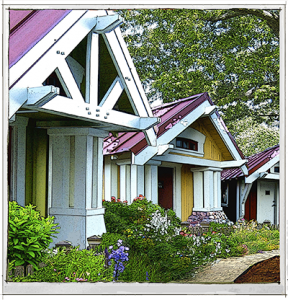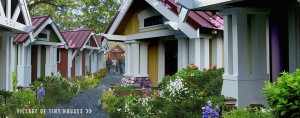Share This
Related Posts
Tags
A Tiny House Village
By Yardi Blog Staff on Apr 11, 2013 in News
Micro-living isn’t just a hot topic for urban apartment markets. Whether in the form of container homes, Canadian laneway houses or tiny condos, downsizing is an increasingly popular option for people who prioritize simplicity over spaciousness.
California home design visionary Jay Shafer, author of The Small House Book, has brought to life a bold vision of micro-living through his Four Lights Houses, a company dedicated to the creation of beautiful, functional, little dwellings for people who believe in living large in tiny spaces. But achieving perfection in the art of simple living is no easy thing.
“To work well, such a structure has to meet the specific needs of its occupant(s), without waste or excess,” says Shafer. “The houses I currently offer through Four Lights Tiny House Company are designed to do just that: provide homeowners with everything they want and need, and nothing they don’t. To date, they are my very best.”
Jay’s dwellings are nothing but ordinary. He spent the past eighteen years re-thinking and refining his designs to provide the best living arrangement for a contemporary lifestyle. His tiny homes are highly-functional, cozy, expressive and adjustable. The materials and proportions of these singular structures far exceed the quality of most suburban houses. In addition, they come in various sizes, including a 120-square-foot dwelling which has been configured to fit between the wheel wells of a standard car hauler. Slightly larger houses range from about 280 square feet (plus another optional 250sf for prospective loft space) to 380sf (plus 350sf optional loft space).
Taking his dream even further, Jay and his partners, Yohan Morgan and Mark Sowers, have started laying the foundations of another daring project. In collaboration with Sonoma County’s zoning department, they plan to build a tiny house village in Northern California, possibly on a prime piece of real estate in downtown Forestville, Calif. The envisioned property is ideally located on a gentle south-facing 8-acre slope within walking distance of amenities.
Aiming to create a contagious model for responsible, affordable and desirable housing, the developers have designed the Napoleon Complex, a tiny village community that would comprise 40 -70 houses at 270 sq. ft. – 700 sq. ft. each (including sleeping lofts).
To add a plus of comfort and facilitate interaction between residents, the development will feature various amenities including an 800 – 1600 sq. ft. common house, private gardens, 1.5 parking spaces per house, shared outdoor space, private storage units, and prominent pedestrian walkways out front with parking out back.
Structured as a co-op, the place will be zoned as an R.V. park, but will look and feel more like a small town community – vibrant and welcoming. “Folks will own their own portable house and the small parcel it sits on, and they’ll pay a set amount per month to maintain the common facilities.” Jay explains. “There will be some rules established by the community to, presumably, keep anyone from turning their stereos up to eleven without earphones, conducting gang warfare on the streets and/or barking incessantly all night-and-day. I imagine one advantage to this particular arrangement might be that if someone feels the irresistible urge to bark all the time, they can simply leave and take their house with them.”
The project’s completion date is set for 2015.
To gain further insight on the tiny homes concept, we have talked to Mark Sowers, general manager of the Four Lights Tiny House Company.
 Amalia Otet: What drew you to the idea of tiny houses in the first place?
Amalia Otet: What drew you to the idea of tiny houses in the first place?
Mark Sowers: Any possessions that aren’t working FOR a person, are working against her. A house reduced to its essentials will offer the best standard of living.
AO: When did you start working and what’s the current status of the Napoleon Complex?
MS: Jay first started dreaming of a tiny house village more than 10 years ago.
Currently, the Napoleon Complex is a set of more than 30 complete RV-park layouts designed by Jay, a team of 3 leaders, vocal support from elected officials and planning department management, a list of possible sites, and likely a cohousing approach to development. The next step will be to convene a ‘getting it built’ workshop with prospective residents and consulting cohousing experts.
AO: Is this your first plunge in the affordable housing sector?
MS: It depends on definitions of affordable housing, I guess. Does Jay’s own house count? Do scores of DIY tiny houses count? If only multi-unit development counts, then… …well, even then, Yohan Morgan has been a project manager developing affordable (conventional) housing for some 25 years. So, no – the core team is not unfamiliar with the affordable housing sector.
AO: How possible are these homes in CA? Are they viable solutions for California residents?
MS: We think they are more than possible. They are inevitable. In fact, RV parks and mobile home parks are already popular. We just propose making them look like attractive traditional neighborhoods, and designing the neighborhoods to best support a strong community connection among the residents.
We believe that Four Lights offers the most attractive and best designs among all tiny houses. Are these viable for California residents? Yes, these tiny house villages will offer lower-cost alternatives to conventionally-sized foundation built homes, but they will NOT be the lowest-cost option. We are not even trying to make the lowest-cost option. We are striving to make the BEST option.
AO: Describe the homes themselves. What materials do you use and how do you make them sustainable? Have you decided on the appliances?
MS: Essential quality houses. They look like houses. Perfectly proportioned houses. Carefully detailed houses. Houses which are better designs than MOST luxury custom homes, no matter how large.
Wood is the predominant material. Cedar siding is a good exterior choice, but painted and maintained douglas fir can also work well. Quality true-divided-light windows distinguish the best homes from the good and the mediocre. Standing seam metal roofing is a handsome and enduring upgrade from the asphalt and composite shingles which adorn the majority of residential roofs in North America.
We believe that the most important choices affecting sustainability are size and durability. The smaller the house, the smaller the ecological footprint. The longer the house endures and is utilized, the smaller the footprint. It is only after these are achieved, that material sourcing and energy efficiency become the next highest priority. In our furnished house plans, we specify some appliances. Here, we are not brand-loyal, nor are we attached exclusively to any particular models.
AO: How do utilities work?
MS: That depends more upon the owners’ location for the house, than it does upon our house design. Park model RVs tend to be built for regular 110V electrical power, and for ‘permanent’ septic hook-ups. For tiny houses in RV parks and mobile home parks, this will be the most likely choice.
In the RV parks each unit will be separately metered for utilities—gas, electricity, telecommunications, and perhaps water. Separate metering is the best way to encourage and reward conservation of these precious resources.
For off-the-grid locations, owners might choose 12V DC appliances and lighting, and they might opt for some sort of composting toilet.
AO: Are there any major obstacles to overcome when starting off a tiny homes project?
MS: Making the firm decision to do it, as with anything worth doing in life – this is probably the most important obstacle, and it’s a mental one.
Beyond that, deciding WHERE to locate the home is a bigger obstacle for most people than it is to decide upon a model or a design of house…as far as we can tell.
AO: Tell us about how you’re finally getting to start making your dream of a tiny house village a reality.
MS: By pulling the right people together in the right ways. People for whom money is ‘gas in the tank’ of the road trip which is life. And yet people who make and keep clear commitments to each other, and who value their relationships even more than their little dream houses.
Regarding bringing people together in the right ways: There will be more RV parks of tiny houses, and more ‘villages’ than what Four Lights’ leads, and these will differ significantly from each other. Four Lights is seeking a quality of community life for the residents which conventional RV park ownership models will not achieve; that is a primary reason for favoring the cohousing model of development. Because for your quality of life, your relationship to your neighbors may be even more important than the efficiency of your house design.
Finally, we are advancing on our village dream by doing it in the right space-time continuum – in an area where elected officials clearly see the local need for new affordable housing options, and at a time when people are actively seeking such homes and neighborhoods.

